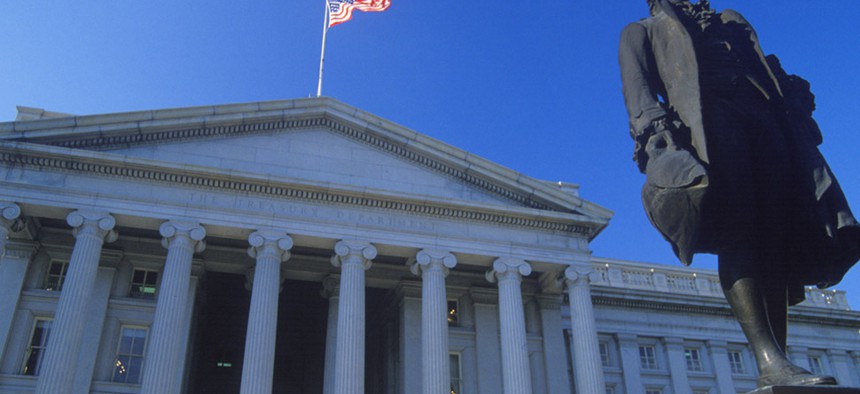Don't Worry About the U.S. Hitting Its Debt Limit Yet
Thanks to increases in tax revenue, a sliding deficit, and extraordinary measures by the Treasury Department, there is time before the U.S. could default.
The United States might have picked the perfect time to hit its debt limit.
On Monday, the U.S. officially hit the amount it is legally able to borrow, after the limit had been suspended in February 2014. But as the Congressional Budget Office has noted, there are a series of steps the Treasury Department can take that would give Congress until October or November to avoid a default.
A study out Monday from the Bipartisan Policy Center lays out just what factors and steps are now coming together to give Congress some breathing room.
One of the factors has to do with when people pay their taxes. Shai Akabas, associate economic policy director at BPC and one of the coauthors of the report, said that in the coming months the government will receive many net tax receipts.
"That's because a lot of these folks that are owed tax refunds file in the earlier part of tax season," Akabas told National Journal. "The people who are filing who owe additional money to the government will be filing tax revenue later this season." This essentially means there will likely be more money coming in April, when more people who owe the government money will be filing.
The government's timeline also benefits, according to the study, from a sliding deficit. The Congressional Budget Office projects that the deficit will stay at less than $500 billion for fiscal year 2015, meaning the debt will increase at a slower rate and thereby allow the Treasury Department to take measures to prevent default at a slower pace.
Another factor that may increase the amount of time is the Treasury Department's ability to take actions ensuring the U.S. does not default. In a letter to congressional leadership last week, Treasury Secretary Jacob Lew said he planned to take extraordinary measures to prevent a default, as the department has done in other recent debt-ceiling standoffs.
"When operating at the Debt limit, the Treasury can choose not to fully invest those once a day," Brian Collins, a senior policy analyst at the Bipartisan Policy Center who coauthored the study, told National Journal. "When that debt goes off the books, it creates room to issue debt to the public to raise cash and pay bills."
The first of the two largest measures that could be taken to prevent default is allowing the Treasury Department to postpone new investments in the Civil Service Retirement and Disability Fund, which provides defined benefits to retired and disabled federal employees under the Civil Service Retirement System. From there, the department can redeem certain existing investments in the fund. This frees up about $6.8 billion in headroom above the debt limit per month.
Another possible measure the department could undertake would be to suspend daily reinvestment of the Government Securities Investment Fund, known as the G Fund, which is a money market-defined retirement contribution fund for federal employees that is invested in special-issue Treasury securities.
Credit-rating agency Moody's also said it fully expected that if expenditure cuts needed to be made as a result of the debt ceiling, the Treasury Department would prioritize interest payments to preserve the full faith and credit of the U.S.
This does not mean Congress has unlimited time to raise the limit, or that there are no risks here. The BPC study lined up with what the CBO found earlier, saying the U.S. will have to meet its obligations likely between October and December of this year. The BPC also noted that Congress has a long list of issues to deal with, including the Medicare physician-payment formula, the Highway Trust Fund, and the Children's Health Insurance Program, that could eat up time that could otherwise be used on deliberating the debt limit.
On previous occasions, Congress has waited until the last minute to raise the debt limit before defaulting on debt, and in 2011, Standard & Poor's downgraded the U.S. credit rating as a result. These standoffs will likely persist now that Republicans have a majority in both houses of Congress while Barack Obama is still president. The comment from Moody's on the debt ceiling took a direct swipe at political gridlock.
"The political impasse over raising the debt limit is a negative feature of U.S. fiscal management," the comment said. "However, even with this feature, the ability of the government to make timely interest payments is intact."
(Image via American Spirit / Shutterstock.com )
NEXT STORY: Five Ways to Avoid GAO’s High-Risk List



